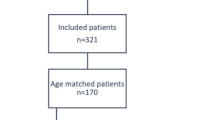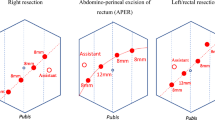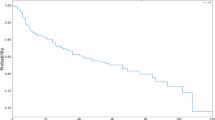Key Points
-
10 years of data support the efficacy and safety of robotic sacrocolpopexy (RSC)
-
RSC is associated with less blood loss, pain, and faster recovery time than abdominal sacrocolpopexy (ASC)
-
RSC has a shorter learning curve than LSC
-
Success with RSC depends on meticulous attention at several key surgical points
Abstract
Robotic sacrocolpopexy (RSC) has rapidly gained popularity over the past 10 years, owing to claims that it is associated with a reduced learning curve compared with standard laparoscopic sacrocolpopexy (LSC) and that it has equal efficacy to the gold-standard treatment, abdominal sacrocolpopexy (ASC). The specifics of the surgical technique used for RSC vary widely, but the basic steps and principles are largely the same. Although complication rates are low, specific complications can be minimized by meticulous attention to surgical technique at several important points in the procedure. Multiple levels of evidence support the efficacy of RSC, and show that it is associated with a shorter hospital stay and convalescence than ASC. The learning curve for RSC usually comprises 10–20 procedures but for those with extensive experience of laparoscopy it is likely to be even shorter. RSC is more expensive than LSC but cheaper than ASC. As RSC has only been used for about a decade, we await long-term outcomes of more than a few years.
This is a preview of subscription content, access via your institution
Access options
Subscribe to this journal
Receive 12 print issues and online access
$209.00 per year
only $17.42 per issue
Buy this article
- Purchase on Springer Link
- Instant access to full article PDF
Prices may be subject to local taxes which are calculated during checkout



Similar content being viewed by others
References
Wu, J. M., Matthews, C. A., Conover, M. M., Pate, V. & Jonsson Funk, M. Lifetime risk of stress urinary incontinence or pelvic organ prolapse surgery. Obstet. Gynecol. 123, 1201–1206 (2014).
Lane, F. E. Repair of posthysterectomy vaginal-vault prolapse. Obstet. Gynecol. 20, 72–77 (1962).
Nygaard, I. et al. Abdominal sacrocolpopexy: a comprehensive review. Obstet. Gynecol. 104, 805–823 (2004).
Nezhat, C. H., Nezhat, F. & Nezhat, C. Laparoscopic sacral colpopexy for vaginal vault prolapse. Obstet. Gynecol. 84, 885–888 (1994).
Ganatra, A. M. et al. The current status of laparoscopic sacrocolpopexy: a review. Eur. Urol. 55, 1089–1103 (2009).
Tarr, M. E. et al. Comparison of postural ergonomics between laparoscopic and robotic sacrocolpopexy: a pilot study. J. Minim. Invasive Gynecol. 22, 234–238 (2015).
Di Marco, D. S., Chow, G. K., Gettman, M. T. & Elliott, D. S. Robotic-assisted laparoscopic sacrocolpopexy for treatment of vaginal vault prolapse. Urology 63, 373–376 (2004).
Anger, J. T. et al. Robotic compared with laparoscopic sacrocolpopexy: a randomized controlled trial. Obstet. Gynecol. 123, 5–12 (2014).
Paraiso, M. F., Jelovsek, J. E., Frick, A., Chen, C. C. & Barber, M. D. Laparoscopic compared with robotic sacrocolpopexy for vaginal prolapse: a randomized controlled trial. Obstet. Gynecol. 118, 1005–1013 (2011).
Serati, M. et al. Robot-assisted sacrocolpopexy for pelvic organ prolapse: a systematic review and meta-analysis of comparative studies. Eur. Urol. 66, 303–318 (2014).
Lowenstein, L. et al. Steep Trendelenburg position during robotic sacrocolpopexy and heart rate variability. Eur. J. Obstet. Gynecol. Reprod. Biol. 178, 66–69 (2014).
Ghomi, A., Kramer, C., Askari, R., Chavan, N. R. & Einarsson, J. I. Trendelenburg position in gynecologic robotic-assisted surgery. J. Minim. Invasive Gynecol. 19, 485–489 (2012).
Osmundsen, B. C. et al. Mesh erosion in robotic sacrocolpopexy. Female Pelvic Med. Reconstr. Surg. 18, 86–88 (2012).
Germain, A. et al. Long-term outcomes after totally robotic sacrocolpopexy for treatment of pelvic organ prolapse. Surg. Endosc. 27, 525–529 (2013).
Ploumidis, A. et al. Robot-assisted sacrocolpopexy for pelvic organ prolapse: surgical technique and outcomes at a single high-volume institution. Eur. Urol. 65, 138–145 (2014).
Mourik, S. L., Martens, J. E. & Aktas, M. Uterine preservation in pelvic organ prolapse using robot assisted laparoscopic sacrohysteropexy: quality of life and technique. Eur. J. Obstet. Gynecol. Reprod. Biol. 165, 122–127 (2012).
Moreno Sierra, J. et al. Long-term outcomes after robotic sacrocolpopexy in pelvic organ prolapse: prospective analysis. Urol. Int. 86, 414–418 (2011).
Vitobello, D., Siesto, G. & Bulletti, C. Robotic sacral hysteropexy for pelvic organ prolapse. Int. J. Med. Robot. 8, 114–117 (2012).
Ayav, A., Bresler, L., Hubert, J., Brunaud, L. & Boissel, P. Robotic-assisted pelvic organ prolapse surgery. Surg. Endosc. 19, 1200–1203 (2005).
Lee, T., Rosenblum, N., Nitti, V. & Brucker, B. M. Uterine sparing robotic-assisted laparoscopic sacrohysteropexy for pelvic organ prolapse: safety and feasibility. J. Endourol. 27, 1131–1136 (2013).
Benson, A. D., Kramer, B. A., Wayment, R. O. & Schwartz, B. F. Supracervical robotic-assisted laparoscopic sacrocolpopexy for pelvic organ prolapse. JSLS 14, 525–530 (2010).
Geller, E. J., Parnell, B. A. & Dunivan, G. C. Pelvic floor function before and after robotic sacrocolpopexy: one-year outcomes. J. Minim. Invasive Gynecol. 18, 322–327 (2011).
Geller, E. J., Lin, F. C. & Matthews, C. A. Analysis of robotic performance times to improve operative efficiency. J. Minim. Invasive Gynecol. 20, 43–48 (2013).
Hoyte, L., Rabbanifard, R., Mezzich, J., Bassaly, R. & Downes, K. Cost analysis of open versus robotic-assisted sacrocolpopexy. Female Pelvic Med. Reconstr. Surg. 18, 335–339 (2012).
Matthews, C. A., Carroll, A., Hill, A., Ramakrishnan, V. & Gill, E. J. Prospective evaluation of surgical outcomes of robot-assisted sacrocolpopexy and sacrocervicopexy for the management of apical pelvic support defects. South. Med. J. 105, 274–278 (2012).
Siddiqui, N. Y., Geller, E. J. & Visco, A. G. Symptomatic and anatomic 1-year outcomes after robotic and abdominal sacrocolpopexy. Am. J. Obstet. Gynecol. 206, 435.e1–435.e5 (2012).
Unger, C. A., Paraiso, M. F., Jelovsek, J. E., Barber, M. D. & Ridgeway, B. Perioperative adverse events after minimally invasive abdominal sacrocolpopexy. Am. J. Obstet. Gynecol. 211, 547.e1–547.e8 (2014).
Akl, M. N. et al. Robotic-assisted sacrocolpopexy: technique and learning curve. Surg. Endosc. 23, 2390–2394 (2009).
Bedaiwy, M. A. et al. The impact of training residents on the outcome of robotic-assisted sacrocolpopexy. Minim. Invasive Surg. http://dx.doi.org/10.1155/2012/289342 (2012).
Borahay, M. A. et al. Outcomes of robotic sacrocolpopexy using barbed delayed absorbable sutures. J. Minim. Invasive Gynecol. 21, 412–416 (2014).
Culligan, P. J. et al. Subjective and objective results 1 year after robotic sacrocolpopexy using a lightweight Y-mesh. Int. Urogynecol. J. 25, 731–735 (2014).
Pulliam, S. J., Weinstein, M. M. & Wakamatsu, M. M. Minimally invasive apical sacropexy: a retrospective review of laparoscopic and robotic operating room experiences. Female Pelvic Med. Reconstr. Surg. 18, 122–126 (2012).
US Food and Drud Administration. Quantitative Assessment of the Prevalence of Unsuspected Uterine Sarcoma in Women Undergoing Treatment of Uterine Fibroids [online], (2014).
Wan, O. Y., Cheung, R. Y., Chan, S. S. & Chung, T. K. Risk of malignancy in women who underwent hysterectomy for uterine prolapse. Aust. N. Z. J. Obstet. Gynaecol. 53, 190–196 (2013).
Crane, A. K., Geller, E. J. & Matthews, C. A. Outlet constipation 1 year after robotic sacrocolpopexy with and without concomitant posterior repair. South. Med. J. 106, 409–414 (2013).
Louis-Sylvestre, C. & Herry, M. Robotic-assisted laparoscopic sacrocolpopexy for stage III pelvic organ prolapse. Int. Urogynecol. J. 24, 731–733 (2013).
Salamon, C. G., Lewis, C., Priestley, J., Gurshumov, E. & Culligan, P. J. Prospective study of an ultra-lightweight polypropylene Y mesh for robotic sacrocolpopexy. Int. Urogynecol. J. 24, 1371–1375 (2013).
Tan-Kim, J., Menefee, S. A., Luber, K. M., Nager, C. W. & Lukacz, E. S. Robotic-assisted and laparoscopic sacrocolpopexy: comparing operative times, costs and outcomes. Female Pelvic Med. Reconstr. Surg. 17, 44–49 (2011).
Barboglio, P. G., Toler, A. J. & Triaca, V. Robotic sacrocolpopexy for the management of pelvic organ prolapse: a review of midterm surgical and quality of life outcomes. Female Pelvic Med. Reconstr. Surg. 20, 38–43 (2014).
Geller, E. J., Parnell, B. A. & Dunivan, G. C. Robotic vs abdominal sacrocolpopexy: 44-month pelvic floor outcomes. Urology 79, 532–536 (2012).
Awad, N. et al. Implementation of a new procedure: laparoscopic versus robotic sacrocolpopexy. Arch. Gynecol. Obstet. 287, 1181–1186 (2013).
Azadi, A. et al. The anatomical outcome of robotic sacrocolpopexy for treatment of pelvic organ prolapse: a comparison of obese and non-obese patients. Surg. Technol. Int. 24, 249–252 (2014).
Goldman, H. B. in Expert opinions in female pelvic medicine and reconstructive surgery. Ch. 33 (eds Vasavada, S. P. & Goldman, H. B.) 171–172 (JP Medical Publishers, 2013).
Belsante, M., Murray, S., Dillon, B. & Zimmern, P. Mid term outcome of robotic mesh sacrocolpopexy. Can. J. Urol. 20, 6656–6661 (2013).
Kramer, B. A., Whelan, C. M., Powell, T. M. & Schwartz, B. F. Robot-assisted laparoscopic sacrocolpopexy as management for pelvic organ prolapse. J. Endourol. 23, 655–658 (2009).
Shepherd, J. P., Higdon, H. L. III, Stanford, E. J. & Mattox, T. F. Effect of suture selection on the rate of suture or mesh erosion and surgery failure in abdominal sacrocolpopexy. Female Pelvic Med. Reconstr. Surg. 16, 229–233 (2010).
Chan, C. M., Liang, H. H., Go, W. W., To, W. W. & Mok, K. M. Laparoscopic sacrocolpopexy for uterine and post-hysterectomy prolapse: anatomical and functional outcomes. Hong Kong Med. J. 17, 301–305 (2011).
Muffly, T. M., Diwadkar, G. B. & Paraiso, M. F. Lumbosacral osteomyelitis after robot-assisted total laparoscopic hysterectomy and sacral colpopexy. Int. Urogynecol. J. 21, 1569–1571 (2010).
Nosseir, S. B., Kim, Y. H., Lind, L. R. & Winkler, H. A. Sacral osteomyelitis after robotically assisted laparoscopic sacral colpopexy. Obstet. Gynecol. 116 (Suppl.), 513–515 (2010).
Good, M. M. et al. Preventing L5–S1 discitis associated with sacrocolpopexy. Obstet. Gynecol. 121, 285–290 (2013).
Anand, M., Tanouye, S. L. & Gebhart, J. B. Vesicosacrofistulization after robotically assisted laparoscopic sacrocolpopexy. Female Pelvic Med. Reconstr. Surg. 20, 180–183 (2014).
White, A. B. et al. Optimal location and orientation of suture placement in abdominal sacrocolpopexy. Obstet. Gynecol. 113, 1098–1103 (2009).
Graham, E., Akl, A., Brubaker, L., Fitzgerald, C. M. & Mueller, E. R. Disk at risk: sacral suture depth in minimally invasive sacrocolpopexy. Female Pelvic Med. Reconstr. Surg. 20, S226 (2014).
Anand, M. et al. Perioperative complications of robotic sacrocolpopexy for post-hysterectomy vaginal vault prolapse. Int. Urogynecol. J. 25, 1193–1200 (2014).
Elneil, S. et al. Abdominal sacrocolpopexy for vault prolapse without burial of mesh: a case series. BJOG 112, 486–489 (2005).
Elliott, D. S., Krambeck, A. E. & Chow, G. K. Long-term results of robotic assisted laparoscopic sacrocolpopexy for the treatment of high grade vaginal vault prolapse. J. Urol. 176, 655–659 (2006).
Barber, M. D. et al. Defining success after surgery for pelvic organ prolapse. Obstet. Gynecol. 114, 600–609 (2009).
Swift, S. E., Tate, S. B. & Nicholas, J. Correlation of symptoms with degree of pelvic organ support in a general population of women: what is pelvic organ prolapse? Am. J. Obstet. Gynecol. 189, 372–379 (2003).
Merseburger, A. S. et al. EAU guidelines on robotic and single-site surgery in urology. Eur. Urol. 64, 277–291 (2013).
De La Cruz, J. F., Myers, E. M. & Geller, E. J. Vaginal versus robotic hysterectomy and concomitant pelvic support surgery: a comparison of postoperative vaginal length and sexual function. J. Minim. Invasive Gynecol. 21, 1010–1014 (2014).
Elliott, C. S. et al. Robot-assisted versus open sacrocolpopexy: a cost-minimization analysis. J. Urol. 187, 638–643 (2012).
Paraiso, M. F. & Chen, C. C. Laparoscopic surgery for pelvic organ prolapse. Minerva Ginecol. 58, 381–391 (2006).
Gocmen, A., Sanlikan, F. & Ucar, M. G. Robotic-assisted sacrocolpopexy/sacrocervicopexy repair of pelvic organ prolapse: initial experience. Arch. Gynecol. Obstet. 285, 683–688 (2012).
Seror, J. et al. Prospective comparison of short-term functional outcomes obtained after pure laparoscopic and robot-assisted laparoscopic sacrocolpopexy. World J. Urol. 30, 393–398 (2012).
Xylinas, E. et al. Robot-assisted laparoscopic sacral colpopexy: initial experience in a high-volume laparoscopic reference center. J. Endourol. 24, 1985–1989 (2010).
Collins, S. A., Tulikangas, P. K. & O'Sullivan, D. M. Effect of surgical approach on physical activity and pain control after sacral colpopexy. Am. J. Obstet. Gynecol. 206, 438.e1–438.e6 (2012).
Li, H. et al. Utilization and perioperative outcomes of robotic vaginal vault suspension compared to abdominal or vaginal approaches for pelvic organ prolapse. Can. Urol. Assoc. J. 8, 100–106 (2014).
Nosti, P. A. et al. Outcomes of abdominal and minimally invasive sacrocolpopexy: a retrospective cohort study. Female Pelvic Med. Reconstr. Surg. 20, 33–37 (2014).
Antosh, D. D. et al. Short-term outcomes of robotic versus conventional laparoscopic sacral colpopexy. Female Pelvic Med. Reconstr. Surg. 18, 158–161 (2012).
Robinson, B. L. et al. Robotic versus vaginal urogynecologic surgery: a retrospective cohort study of perioperative complications in elderly women. Female Pelvic Med. Reconstr. Surg. 94, 230–237 (2013).
Desai, P. H., Lin, J. F. & Slomovitz, B. M. Milestones to optimal adoption of robotic technology in gynecology. Obstet. Gynecol. 123, 13–20 (2014).
Judd, J. P. et al. Cost-minimization analysis of robotic-assisted, laparoscopic, and abdominal sacrocolpopexy. J. Minim. Invasive Gynecol. 17, 493–499 (2010).
Skoczylas, L. C., Turner, L. C., Wang, L., Winger, D. G. & Shepherd, J. P. Changes in prolapse surgery trends relative to FDA notifications regarding vaginal mesh. Int. Urogynecol. J. 25, 471–477 (2014).
Bassaly, R. et al. Technical preferences of surgeons performing a sacrocolpopexy procedure. Surg. Technol. Int. 22, 189–194 (2012).
Author information
Authors and Affiliations
Contributions
Both authors made a substantial contribution to discussion of content, wrote the article and reviewed and edited the manuscript before submission. K.P.S. researched data for the article.
Corresponding author
Ethics declarations
Competing interests
The authors declare no competing financial interests.
Rights and permissions
About this article
Cite this article
Sajadi, K., Goldman, H. Robotic pelvic organ prolapse surgery. Nat Rev Urol 12, 216–224 (2015). https://doi.org/10.1038/nrurol.2015.51
Published:
Issue Date:
DOI: https://doi.org/10.1038/nrurol.2015.51
This article is cited by
-
The effect of concomitant hysterectomy on complications following pelvic organ prolapse surgery
Archives of Gynecology and Obstetrics (2023)
-
The impact of fellowship surgical training on operative time and patient morbidity during robotics-assisted sacrocolpopexy
International Urogynecology Journal (2018)



